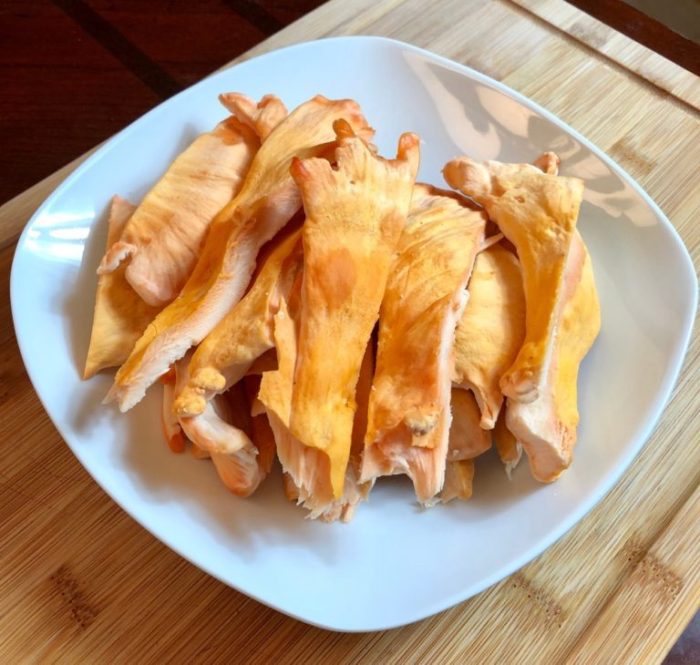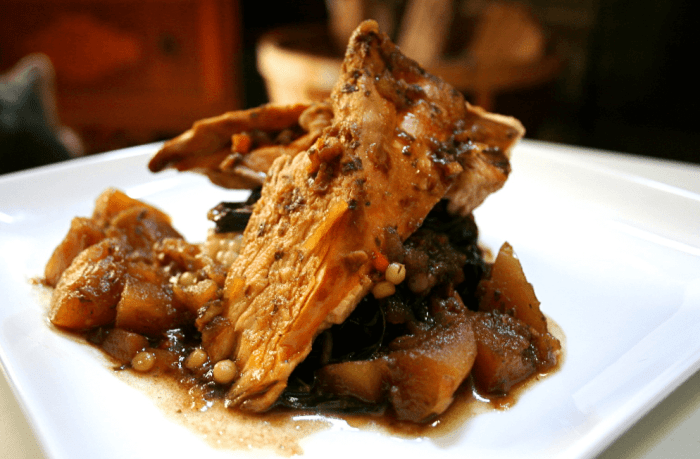
Embark on a culinary adventure with the chicken of the woods recipe, where the flavors of the forest meet the comfort of your kitchen. This wild mushroom, known for its vibrant colors and delectable taste, is a versatile ingredient that will transform your meals into extraordinary feasts.
Whether you’re a seasoned forager or a curious cook, this guide will provide you with everything you need to know about chicken of the woods mushrooms, from identifying them in the wild to creating mouthwatering dishes that will impress your taste buds.
Recipe Exploration

Chicken of the woods mushrooms offer a versatile culinary experience, inspiring a diverse range of recipes. From grilling to sautéing and baking, these mushrooms can be transformed into delectable dishes that cater to various cuisines and flavor profiles.
Grilling
- Grilled Chicken of the Woods with Herb Butter: Marinated in a savory blend of herbs and butter, these grilled mushrooms retain their juicy texture and earthy flavor.
- Chicken of the Woods Kebabs: Skewered with vegetables or other mushrooms, these kebabs are a flavorful and colorful addition to any barbecue.
Sautéing
- Sautéed Chicken of the Woods with Garlic and Thyme: Sautéed in butter with aromatic garlic and thyme, these mushrooms become tender and develop a rich, umami flavor.
- Chicken of the Woods Stir-Fry: Tossed in a flavorful sauce with vegetables, these mushrooms add a meaty texture and earthy notes to stir-fries.
Baking
- Baked Chicken of the Woods with Parmesan: Baked with grated Parmesan cheese, these mushrooms become crispy on the edges and develop a cheesy, nutty flavor.
- Chicken of the Woods Pizza: Topped on a crispy pizza crust with your favorite sauce and toppings, these mushrooms add a unique and savory twist to this classic dish.
Nutritional Benefits

Chicken of the woods mushrooms are a nutritional powerhouse, offering an impressive array of essential nutrients. They are a rich source of protein, fiber, and antioxidants, contributing to their potential health benefits.
Protein is crucial for building and repairing tissues, while fiber promotes satiety, supports digestive health, and regulates blood sugar levels. Additionally, chicken of the woods mushrooms are loaded with antioxidants, which protect cells from damage caused by free radicals.
Antioxidant Content, Chicken of the woods recipe
Chicken of the woods mushrooms contain a diverse range of antioxidants, including ergothioneine, hericenones, and phenolics. Ergothioneine is a unique antioxidant that is particularly effective at protecting cells from oxidative stress. Hericenones are polysaccharides with antioxidant and anti-inflammatory properties, while phenolics are plant compounds that have been linked to reduced risk of chronic diseases.
If you’re a fan of wild mushrooms, you’ll love this chicken of the woods recipe . These bright orange fungi are packed with flavor and can be used in a variety of dishes. Whether you’re sautéing them with garlic and butter or using them in a hearty stew, you’re sure to enjoy their unique taste.
Foraging and Identification
Venturing into the woods to forage for chicken of the woods mushrooms can be a thrilling experience. But before you embark on this adventure, it’s crucial to equip yourself with the knowledge to identify them safely and accurately.
For a vegetarian twist on a classic dish, try this chicken of the woods recipe . The meaty texture of these mushrooms makes them a great substitute for chicken in stir-fries, tacos, or even sandwiches. They’re also a good source of protein and fiber, making them a healthy addition to any meal.
Typical Habitat and Seasonality
Chicken of the woods mushrooms thrive in deciduous forests, particularly near oak trees. They often grow at the base of these trees or on fallen logs. Their prime season typically spans from late summer to early fall, but this can vary depending on the region and weather conditions.
Identifying Chicken of the Woods
To ensure you’re harvesting the right mushrooms, pay close attention to these key characteristics:
- Size and Shape:Chicken of the woods mushrooms are typically large, with a shelf-like or fan-shaped appearance. They can range in size from a few inches to over a foot in width.
- Color:They exhibit a vibrant orange or yellow color, sometimes with reddish hues. The color can vary in intensity, but it’s generally bright and eye-catching.
- Texture:These mushrooms have a soft, fleshy texture that’s tender when cooked. They are not slimy or rubbery.
- Gills:On the underside of the mushroom, you’ll find dense, white gills that extend all the way down to the stem.
- Stem:Chicken of the woods mushrooms typically have a short, thick stem that attaches them to the tree or log. The stem is usually white or cream-colored.
Look-Alikes to Avoid
While chicken of the woods mushrooms are generally easy to identify, it’s important to be aware of a few look-alikes to avoid:
- False Chicken of the Woods (Laetiporus sulphureus): This mushroom is very similar in appearance to chicken of the woods, but it has a bright yellow color and grows on coniferous trees. It’s considered inedible due to its bitter taste.
- Chicken Fat Mushroom (Gomphus clavatus): These mushrooms are smaller and have a more irregular shape than chicken of the woods. They are also a different color, ranging from pale yellow to orange-brown. They are not poisonous but are not as desirable for eating.
Culinary Applications

Chicken of the woods mushrooms are highly versatile in cooking, lending their unique flavor and texture to a wide range of dishes. Their meaty texture and subtle umami notes make them an excellent substitute for chicken in various recipes.
They can be sautéed, grilled, roasted, or added to soups, stews, and pasta dishes. Their versatility allows for creative culinary experimentation, adding a touch of wild flavor to everyday meals.
Flavor and Texture
Chicken of the woods mushrooms have a distinct flavor that has been described as nutty, slightly sweet, and reminiscent of chicken. Their texture is meaty and slightly chewy, making them a satisfying addition to any dish.
Recipe Customization: Chicken Of The Woods Recipe
Chicken of the woods is a versatile ingredient that can be customized to suit your taste preferences. Here are some ideas for adding your own personal touch to your recipes:
Experiment with different herbs and spices to enhance the flavor of the chicken. Some good options include thyme, rosemary, sage, oregano, paprika, and garlic powder.
Sauces
- Serve the chicken with a variety of sauces, such as a creamy mushroom sauce, a tangy barbecue sauce, or a savory gravy.
Cooking Times and Temperatures
- Adjust the cooking times and temperatures depending on the size and thickness of the chicken pieces. Smaller pieces will cook more quickly than larger ones, and thicker pieces may require a lower temperature to prevent burning.
Final Summary

So, gather your ingredients, ignite your culinary curiosity, and let the chicken of the woods recipe guide you on an unforgettable gastronomic journey. May your meals be filled with the vibrant colors and exquisite flavors of this woodland treasure.
FAQ Resource
Q: Where can I find chicken of the woods mushrooms?
A: Chicken of the woods mushrooms typically grow at the base of oak trees, especially in moist, shady areas.
Q: How do I identify chicken of the woods mushrooms?
A: Look for mushrooms with bright orange to yellow caps and a white, stringy interior. The edges of the caps are often wavy or lobed.
Q: Can I eat chicken of the woods mushrooms raw?
A: No, it’s recommended to cook chicken of the woods mushrooms before eating them to avoid potential digestive issues.





